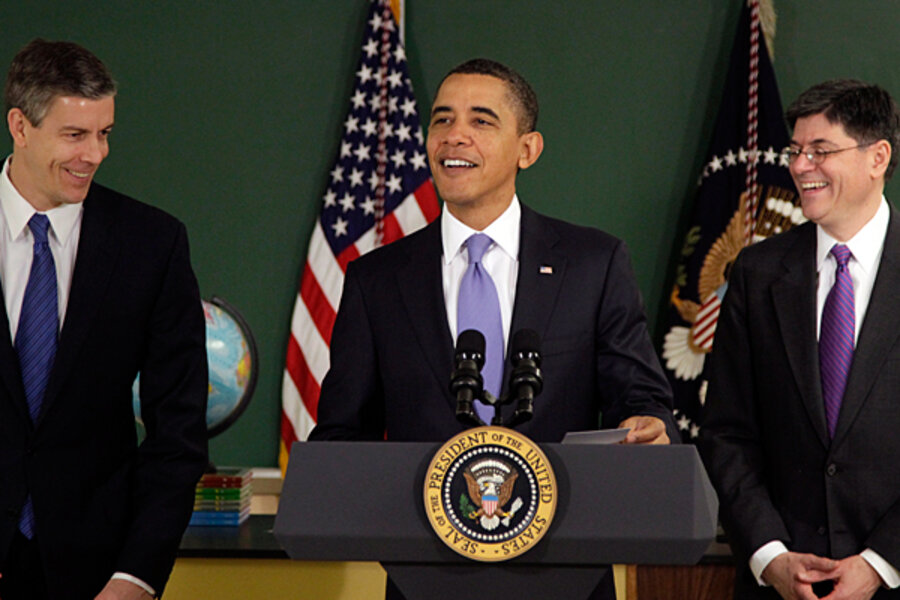Obama's 'have it all' budget: Can he cut, spend, and grow?
Loading...
| Washington
In his proposed 2012 budget, released Monday, President Obama is trying to have it all:
• Increased spending in areas the president believes will spur economic growth by boosting research, innovation, and education.
• A five-year freeze in some discretionary spending, plus cuts to some programs – including defense – in a bow to cries for fiscal responsibility amid unsustainable deficits and skyrocketing debt.
• Tax increases for the oil and gas industries and upper-income individuals, also aimed at both lowering deficits and freeing up money for priority spending.
Taken as a whole, the $3.7 trillion budget proposal would produce a $1.1 trillion deficit for fiscal 2012 – less than this year’s projected deficit of $1.65 trillion. Over 10 years, the federal debt would increase by $7.2 trillion, but the administration says that’s $1.1 trillion less than if its plan were not implemented.
In contrast, the plan issued last December by the president’s deficit commission would have reduced the debt by $4 trillion over 10 years. And on the biggest driver of America’s fiscal imbalance – entitlements, foremost Medicare, Medicaid, and Social Security – Mr. Obama’s budget avoids the cuts called for in the commission co-chairs’ report.
In remarks Monday morning at a technology-oriented middle school in Baltimore, Obama echoed his State of the Union emphasis on “winning the future” and investing in areas – like education – that will boost US competitiveness globally.
"While it's absolutely essential to live within our means, while we are absolutely committed to working with Democrats and Republicans to find further savings and to look at the whole range of budget issues, we can't sacrifice our future in the process," Obama said, as budget director Jacob Lew and Education Secretary Arne Duncan looked on.
"Even as we cut out things that we can afford to do without, we have a responsibility to invest in those areas that will have the biggest impact in our future. And that's especially true when it comes to education," Obama said.
Separately Monday morning, Mr. Lew said the proposed budget would reach the administration’s goal of cutting the deficit in half by the end of Obama’s first term.
Republicans, predictably, reject Obama’s plan and call for far greater spending cuts.
“Clearly, this budget does not rise to the fiscal challenge that we face on three fronts” – annual spending, entitlements, and “pro-growth policies,” said Rob Portman, a Republican senator from Ohio and former budget director under President George W. Bush, on MSNBC.
But like most presidential budgets, Obama is also getting grief from his own party, over proposed cuts to programs that some of his allies consider essential. The cuts include:
• A reduction by half – $2.5 billion – in the low-income heating assistance program, or LIHEAP.
• $300 million in annual Community Development Block Grants aimed at helping low-income people with housing and other poverty-fighting measures.
• More than $1 billion in grants to large airports.
• $950 million in aid to states for water-treatment plants and other infrastructure.
The Pentagon also takes a $78 billion cut.
On the tax-increase end of the equation, Obama proposes ending subsidies for the oil and gas industry, amounting to $46 billion over 10 years, and reducing the rate at which high-income individuals can itemize deductions in areas such as home-mortgage interest and charitable donations. These tax increases account for one-third of the projected $1.1 trillion in deficit reduction over 10 years. The other two-thirds comes from spending cuts.
Administration officials say that the savings from limiting the tax deductions of high-income earners would be used to keep the Alternative Minimum Tax from affecting more middle-class families over the next two years.
On the “investment,” or spending, side of the ledger, the administration proposes $53 billion over the next six years on high-speed rail and $15.7 billion on expanding the nation’s wireless network. Obama would also fund a National Infrastructure Bank with $50 billion, aimed at leveraging private investment.





